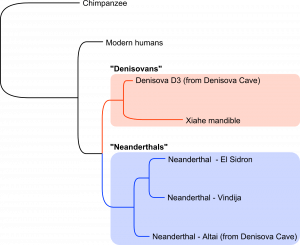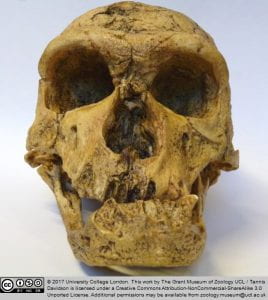The Last of the Neanderthal… Blog Posts!
By Josie Mills, on 26 June 2019
Since I started working for UCL Culture, the picture researchers have of human evolution has changed dramatically. There’s no surprises that I think the most exciting relate to Neanderthals; it’s now widely accepted that they possessed complex material culture, adapted to different climates and environments, and expressed themselves through art and symbolism. Researchers are giving the Neanderthals space to be both similar and different to Anatomically Modern Humans, and questioning whether the comparison between the two species is the most useful way to understand behaviour.
The evolutionary tree has also been updated multiple times as new genomic and anatomical data emerges. We know a whole species, the Denisovans, by evidence almost wholly gleaned from ancient DNA and proteins. The Denisovans were a species with a huge range from Siberia to SE Asia; they were distantly related to Neanderthals and possessed distinct adaptations relating to survival in cold climates. A huge breakthrough in the past few months identified a jawbone, found in 1980 by monks in a cave on the Tibetan Plateau, that actually belonged to an adolescent Denisovan. It’s the largest piece of anatomical evidence found of the species and also greatly expands their known geographical range. The fossil was identified by the presence of ancient proteins preserved in the teeth, via a type of analysis called palaeoproteomics a revolutionary technique that provides an alternative to identification of ancient DNA, which doesn’t always preserve well.

A schematic of the relationship between Neanderthals, Denisovans, Chimpanzees and Anatomically Modern Humans that demonstrates the genetic link between Denisovans and Neanderthals (Image Credit: Frido Welker from this blog post, which discusses the mandible).
Discoveries like this both simplify and complicate our understanding of how humans evolved; it’s really interesting to see how the development of scientific techniques can draw information from finds both in museum archives and within local communities. One of the highlights of being a Student Engager is the chance to be involved with outreach activities like Curiosi-teas, a group that aims to bring local people together with the UCL Collections, fostering a sense of community and taking the museums out of a traditional academic setting. It’s often these sessions that produce the most interesting and also difficult to answer questions about Neanderthals (think cannibalism, brains, sex…). Or one of my personal favourites, did Neanderthals wear clothes? The origin of clothes is a tricky topic because organic material doesn’t preserve well in the archaeological record. We know that Neanderthals lived in cold climates, and although they had certain adaptations to cope with this, I think it’s incredibly unlikely they were wandering around in their birthday suits. Although during this discussion it was suggested that they may have coped with the cold by being excessively hairy…
This will be my final blog post for UCL Researchers in Museums, as our funding has been withdrawn by UCL Culture – we’re facing an Engager-wide extinction event! I want to take a line to thank my colleagues (all 13 of them) and I hope this blog and our presence in UCL Museums has been interesting and engaging for readers and visitors – Although sad, we are leaving on a high as we have just been awarded The Dr Katharine Giles science blog award by the Association of British Science Writers! It’s been a wonderful place to talk about my PhD research and the amazing collections held at UCL and we’ve all learnt a lot from each other – did you know that – did you know that wombats poop cubes?!
I thought I’d finish by pointing you in the direction of a few human evolution and palaeolithic archaeology highlights in the UCL Museums. Firstly, the collection of handaxes and other stone tools in the Petrie Museum. You’ll find them clustered under Flinders Petrie’s watchful gaze in the museum cases located at the earliest point of Egypt’s chronology. They represent some of the first finds from Egypt before it was really Egypt as we know it now, I’ve written about them here. A hot tip, the drawers under the display cases pull out and are chock full of more lovely lithics!

A late Acheulean (Lower Palaeolithic) handaxe found at what is now Thebes. From the collection of Montague Porch 1905, presented to the museum by the public museum of Weston-Super-Mare, January 1960. Dimensions 95mm. (Image Credit: Petrie Museum, UC13676).
Moving to the Grant Museum, you can see some great examples of comparative anatomy of both primates and hominins. This image is a skull cast from a cranium and mandible discovered at La Chappelle-Aux-Saints in France. It’s estimated that this person lived 50,000 years ago, to the ripe old age of 40, which is pretty good for a Neanderthal! It’s one of the most complete Neanderthal skeletons found, and thought to be a deliberate burial. It’s also a fossil that has been discussed in terms of prehistoric altruism and social care, as the skeleton shows signs of bad health, for example arthritis and tooth loss; these pathologies have been used to suggest that the ‘old man’ was cared for by others, which has important implications for group dynamics and is something we associate with humanity. The whole display case provides a great range of different hominin and non-human primate fossil casts, where you can see the differences and similarities between our ancestors.
So, that’s it from your resident Neanderthal enthusiast, if you are interested in human evolution, prehistoric archaeology, ot rocks – follow me on Twitter @josiemills!
 Close
Close


